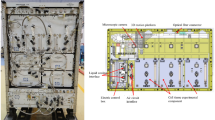Abstract
A bioreactor is an apparatus in which biological processes are performed under controlled conditions. Space bioreactors refer generically to much of the equipment that accommodates biological processes regarding the maintenance and culture of cells in space. The microgravity of space as well as other physical aspects of space travel offer a unique environment in which terrestrial life as modeled in bacteria and cells display their unique fundamental mechanisms of adaptation to microgravity as well as environmental changes caused by microgravity. Understanding these adaptations opens a new platform for development of novel opportunities in bioscience, biotechnology, and bioengineering. Indeed the elucidation of these fundamental mechanisms will allow discrimination of the indirect mechanisms of life responses to microgravity-induced changes in the cell culture environment from direct responses of the cell to the intensity of the gravitational force (e.g., an intrinsic cellular gravimeter).
Access this chapter
Tax calculation will be finalised at checkout
Purchases are for personal use only
Similar content being viewed by others
References
Barilla J, Wilson JW, Soni A, Yang J (2017) Using spaceflight and spaceflight analogue culture for novel mechanistic insight into Salmonella pathogenesis. In: Nickerson CA, Pellis NR, Ott CM (eds) Effect of spaceflight and spaceflight analog culture on human and microbial cells. Springer, pp 209–236
Ferreira RR, Fukui H, Chow RVA, Vermot J (2019) The cilium as a force sensor−myth versus reality. J Cell Sci (132):jcs213496. https://doi.org/10.1242/jcs.213496
Pellis NR (2010) Cells in space. In: Wings in orbit: microgravity research in the space shuttle era. US Government Printing Office, pp 421–430. ISBN 978-0-16-086846-4
Pellis NR, Chouker A, Yic B, Tauber S, Ullrich O, Sundaresan A (2017) Overview and translation impact space cell biology research. In: Nickerson CA, Pellis NR, Ott CM (eds) Effect of spaceflight and spaceflight analog culture on human and microbial cells. Springer, pp 3–38
Pierson DL, Ott CM (2017) Microbial investigation: overview. In: Nickerson CA, Pellis NR, Ott CM (eds) Effect of spaceflight and spaceflight analog culture on human and microbial cells. Springer, pp 199–208
Prasad RM, Jin X, Nauli SM (2014) Sensing a sensor: identifying the mechanosensory function of primary cilia. Biosensors 4:47–62
Wolf DA, Kleis SJ (2017) Principles of analog and true microgravity bioreactors to tissue engineering. In: Nickerson CA, Pellis NR, Ott CM (eds) Effect of spaceflight and spaceflight analog culture on human and microbial cells. Springer, pp 39–60
Author information
Authors and Affiliations
Editor information
Editors and Affiliations
Section Editor information
Rights and permissions
Copyright information
© 2021 Springer Nature Switzerland AG
About this entry
Cite this entry
Pellis, N.R. (2021). Space Bioreactors. In: Young, L.R., Sutton, J.P. (eds) Handbook of Bioastronautics. Springer, Cham. https://doi.org/10.1007/978-3-319-12191-8_41
Download citation
DOI: https://doi.org/10.1007/978-3-319-12191-8_41
Published:
Publisher Name: Springer, Cham
Print ISBN: 978-3-319-12190-1
Online ISBN: 978-3-319-12191-8
eBook Packages: EngineeringReference Module Computer Science and Engineering



